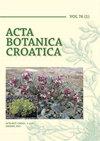The effect of salinity gradient and heavy metal pollution on arbuscular mycorrhizal fungal community structure in some Algerian wetlands
IF 0.7
4区 生物学
Q3 PLANT SCIENCES
引用次数: 4
Abstract
Algerian natural wetlands suffer from anthropogenic disturbances due to industrial development and urbanization. This study was designed to draw attention to arbuscular mycorrhizal fungi (AMF) distribution and community assemblages following heavy metal and salinity concentrations in two wetlands subjected to domestic and industrial effluents. Rhizospheric soil and roots of 18 plant species were collected in two wetlands along a decreasing salinity gradient. The results showed that 72.72% of plant species exhibit an association within arbuscular mycorrhizas (AM), and 36.36% a dual association between AM and dark septate endophytes (DSE). A total of 33 AMF morphospecies were distinguished on the basis of morphological criteria dominated by taxa belonging to Glomeraceae and Acaulosporaceae. Soil contamination was investigated by determining metallic trace elements (MTE) (Cd, Cu, Ni, Pb, Cr and Zn) using an atomic absorption spectrophotometer. Values of the pollution index revealed wetlands that were particularly polluted by lead. Two-way ANOVA showed significant variations in metal content among sampling locations and transects. Principal component analysis showed that species richness, and mycorrhizal frequency were slightly affected by MTE. This opens possibilities for their utilization in polluted soil remediation.盐度梯度和重金属污染对阿尔及利亚湿地丛枝菌根真菌群落结构的影响
由于工业发展和城市化,阿尔及利亚的自然湿地受到人为干扰。本研究旨在引起人们对两个受生活和工业废水影响的湿地中丛枝菌根真菌(AMF)在重金属和盐度浓度下的分布和群落组合的关注。在两个盐度梯度递减的湿地中采集了18种植物的根际土壤和根系。结果表明,72.72%的植物物种表现出丛枝菌根(AM)内的缔合,36.36%的植物物种呈现出AM与暗隔内生菌(DSE)的双重缔合。根据以Glomeraceae和Acaulosporaceae为主要类群的形态学标准,共鉴定出33种AMF形态种。采用原子吸收分光光度计测定了土壤中的金属微量元素(Cd、Cu、Ni、Pb、Cr和Zn),对土壤污染进行了研究。污染指数显示,湿地受到铅的污染尤为严重。双向方差分析显示,不同采样地点和样带的金属含量存在显著差异。主成分分析表明,MTE对物种丰富度和菌根频率影响较小。这为它们在污染土壤修复中的应用开辟了可能性。
本文章由计算机程序翻译,如有差异,请以英文原文为准。
求助全文
约1分钟内获得全文
求助全文
来源期刊

Acta Botanica Croatica
PLANT SCIENCES-
CiteScore
2.50
自引率
0.00%
发文量
34
审稿时长
>12 weeks
期刊介绍:
The interest of the journal is field (terrestrial and aquatic) and experimental botany (including microorganisms, plant viruses, bacteria, unicellular algae), from subcellular level to ecosystems. The attention of the Journal is aimed to the research of karstic areas of the southern Europe, karstic waters and the Adriatic Sea (Mediterranean).
 求助内容:
求助内容: 应助结果提醒方式:
应助结果提醒方式:


